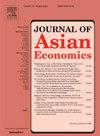Environmental provisions in preferential trade agreements and export product quality of Chinese firms
IF 3.4
3区 经济学
Q1 ECONOMICS
引用次数: 0
Abstract
China’s foreign trade has stepped into a high-quality development track, while at the same time, China has increasingly included different types of environmental provisions in the concluded Preferential Trade Agreements (PTAs). We empirically examine the effect of environmental provisions in PTAs on firms’ export product quality using matched data from the Trade and Environment Database (TREND), the Chinese Customs Transaction-level Trade Statistics Dataset, and the Chinese Annual Survey of Industrial Firms Dataset from 2000 to 2014. The findings show that environmental provisions in PTAs are conducive to improving the quality of Chinese firms’ export products by increasing firms’ productivity and inducing firms to import more intermediate goods. Furthermore, trade-liberal environmental provisions in PTAs tend to improve the quality of firms’ export products quality while trade-prohibitive ones have a negative effect. Additionally, environmental provisions in PTAs are particularly beneficial for firms that are less constrained by financing, as well as for state-owned, foreign, medium-sized, and high emission intensity firms. Our research provides support for promoting China’s participation in global governance through environmental provisions in PTAs while realizing high-quality development of foreign trade.
优惠贸易协定中的环境条款与中国企业出口产品质量
中国对外贸易已步入高质量发展轨道,与此同时,中国在缔结的优惠贸易协定中越来越多地纳入不同类型的环境条款。本文利用2000 - 2014年贸易与环境数据库(TREND)、中国海关交易级贸易统计数据集和中国工业企业年度调查数据集的匹配数据,实证检验了贸易协定中环境条款对企业出口产品质量的影响。研究发现,自由贸易协定中的环境条款通过提高企业生产率和诱导企业进口更多中间产品,有利于提高中国企业出口产品的质量。此外,自由贸易协定中的环境条款倾向于提高企业出口产品的质量,而贸易禁止性条款则有负面影响。此外,协定中的环境条款对受融资限制较少的公司以及国有、外国、中型和高排放强度公司特别有利。我们的研究为推动中国通过自贸区环境条款参与全球治理,实现对外贸易高质量发展提供了支持。
本文章由计算机程序翻译,如有差异,请以英文原文为准。
求助全文
约1分钟内获得全文
求助全文
来源期刊

Journal of Asian Economics
ECONOMICS-
CiteScore
4.70
自引率
9.40%
发文量
90
期刊介绍:
The Journal of Asian Economics provides a forum for publication of increasingly growing research in Asian economic studies and a unique forum for continental Asian economic studies with focus on (i) special studies in adaptive innovation paradigms in Asian economic regimes, (ii) studies relative to unique dimensions of Asian economic development paradigm, as they are investigated by researchers, (iii) comparative studies of development paradigms in other developing continents, Latin America and Africa, (iv) the emerging new pattern of comparative advantages between Asian countries and the United States and North America.
 求助内容:
求助内容: 应助结果提醒方式:
应助结果提醒方式:


